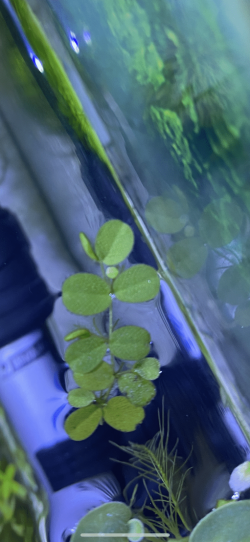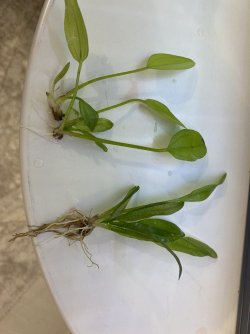You are using an out of date browser. It may not display this or other websites correctly.
You should upgrade or use an alternative browser.
You should upgrade or use an alternative browser.
Is this duckweed or salvinia?
- Thread starter Panadalover93
- Start date
April FOTM Photo Contest Starts Now!

🏆 Click to enter! 🏆
Salvinia, the species possibly S. molesta. There are currently ten recognized species, some of which are very difficult to distinguish apart. Salvinia auriculata is the species often associated with the aquarium plant, but several authors believe this is inaccurate. Kasselmann (2003) suggests that S. molesta is the species most often found in aquaria, and according to Mitchell (1972) is likely a natural hybrid of S. auriculata and S. biloba. S. molesta was described in 1972 by D.S. Mitchell; the species epithet is Latin for damaging or bothersome...I guess he viewed its rapid reproduction as a negative!
Salvinia is a small floating fern, the sole genus in the Salviniaceae family. It consists of three leaves, two floating and one modified leaf submerged that may be mistaken for a root; the stem is branching and creeping, bearing hairs but no true roots. Although native to South America, this plant is very invasive and is now naturalized in Asia, Australia and North America. It is on the list of noxious weeds in the United States. It should never be discarded into waterways, as it has the ability to rapidly spread and choke out indigenous plants.
Salvinia is a small floating fern, the sole genus in the Salviniaceae family. It consists of three leaves, two floating and one modified leaf submerged that may be mistaken for a root; the stem is branching and creeping, bearing hairs but no true roots. Although native to South America, this plant is very invasive and is now naturalized in Asia, Australia and North America. It is on the list of noxious weeds in the United States. It should never be discarded into waterways, as it has the ability to rapidly spread and choke out indigenous plants.
Panadalover93
Fish Fanatic
Could you help me identify these pleaseSalvinia, the species possibly S. molesta. There are currently ten recognized species, some of which are very difficult to distinguish apart. Salvinia auriculata is the species often associated with the aquarium plant, but several authors believe this is inaccurate. Kasselmann (2003) suggests that S. molesta is the species most often found in aquaria, and according to Mitchell (1972) is likely a natural hybrid of S. auriculata and S. biloba. S. molesta was described in 1972 by D.S. Mitchell; the species epithet is Latin for damaging or bothersome...I guess he viewed its rapid reproduction as a negative!
Salvinia is a small floating fern, the sole genus in the Salviniaceae family. It consists of three leaves, two floating and one modified leaf submerged that may be mistaken for a root; the stem is branching and creeping, bearing hairs but no true roots. Although native to South America, this plant is very invasive and is now naturalized in Asia, Australia and North America. It is on the list of noxious weeds in the United States. It should never be discarded into waterways, as it has the ability to rapidly spread and choke out indigenous plants.
Attachments
Could you help me identify these please
Those are Echinodorus species, commonly called "Amazon Sword." You have two species, and identification is not always simple unless one sees the flower, and this rarely occurs in hobbyists' tanks. But the one on the bottom, the longer narrower leaf sword, is probably E. grisebachii, and likely the bleherae variety; this is the most common sword species in the hobby so it is not too much of a stretch to suggest the species when one sees these leaves. Plant it in the substrate, and give it a fertilizer tab like Seachem's Flourish Tabs, just one close to the crown, and put a new tab every 3 months; you will be amazed at the growth.
I'm about as certain as I can be that the upper two plants are not the same species, but E. cordifolius. If it is, it may sometimes be called by the common name "radicans sword," a name derived from the incorrect description/naming by Engelmann in 1848. The petiole (leaf stem) is triangular rather than round in this species, so if that applies to these plants, they are likely E. cordifolius. This species has an extensive geographical range (naturally, not introduced), including the SE United States, Caribbean islands, parts of Mexico, northern coastal areas of Columbia and Venezuela, and the Pantanal area in Brazil and Paraguay. It is found in boggy locations and floodplains. The wide geographical distribution results in considerable morphological variation within this species. Here too, Flourish Tabs will make a huge difference in growth.
Panadalover93
Fish Fanatic
I cant thank you enough
Latest Discussions
- Replies
- 4
- Views
- 97
- Replies
- 9
- Views
- 76
- Replies
- 8
- Views
- 100
trending
-
-
-
-
F-1 Angel... a bit nervous... it'll be my 1st F-1 fish...
- Started by Magnum Man
- Replies: 13
-
Staff online
-
FishmanicTFF Contest Czar
Members online
Total: 454 (members: 9, guests: 445)




